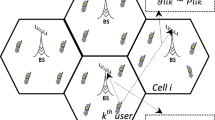Abstract
During the past years, research covering propagation, channelcharacterization and wireless systems performance have yield asubstantial knowledge of the 60 GHz channel. The unlicensed 60 GHzfrequency band presents many attractive properties for wirelesscommunications. The environments in which the 60 GHzinfrastructure are to be designed are typically propagation- andcoverage-limited. This paper describes the important factors thatmust be taken into account when designing a wireless local areanetwork (WLAN) architecture operating in this frequency band.Therefore, we motivate the reasons of using distributedtransmitting antennas and multiple receiving antennas (MRA) inorder to mitigate the poor Direction of Arrival (DoA) diversityand to exploit the spatial diversity at the receiver. Such asystem can be considered as a multiple input multiple output(MIMO) system. We investigate the advantages of combining aVirtual Cellular Network (VCN) (using single frequency network anddistributed antennas) and MRA for the downlink. Several ways tocombine the signals with different levels of complexity arepresented. In the most complex case using Singular ValueDecomposition (SVD), it is possible to add coherently thecontribution of each antenna in a virtual cell while retaining thepath diversity inherent to the VCN infrastructure. The schemesyield several advantages: symbol diversity is improved, pathdiversity is still present, antenna gain using multiplebeamformers is increased and the multipath can be reduced. Theconcept is applicable to most types of single frequency networksbut it is especially well appropriate for the 60 GHz VCN/WLANusing orthogonal frequency division multiplexing (OFDM).Simulations give a realistic performance for QPSK, 8-PSK, and16-QAM baseband modulations with a 256-subcarrier OFDM using arate 1/2–convolutional code for a 2 ×2 VCN system.Results show a Eb/N0 improvement of up to 6.2 dB usingthesingular value decomposition method with 16-QAM compared to thesingle input single output (SISO) coded reference.
Similar content being viewed by others
References
4GWweb, 4GW home page. http://www.s3.kth.se/radio/4GW/.
J. Bakker and R. Prasad, “Handover in a Virtual Cellular Network”, Proc. of IEEE Vehicular Technology Conference, pp. 544–548, 1999.
M. Flament, “On 60 GHz Wireless Communication Systems”, Licenciate Thesis, Chalmers University of Technology, Gothenburg, Sweden, 2000.
J. Hübner, S. Zeisberg, K. Koora and A. Finger, “Channel Model for 60 GHz Indoor Wireless LAN Design Based on Complex Wideband Measurements”, Proc. of IEEE Vehicular Technology Conference, pp. 1004–1008, 1997.
V.K. Jones and G.G. Raleigh, “Channel Estimation for Wireless OFDM Systems”, Proc. of IEEE Global Telecommunications Conference, Vol. 2, pp. 980–985, 1998.
H.J. Kim and J.-P. Linnartz, “Virtual Cellular Network: A New Wireless Communications Architecture with Multiple Access Ports”, Proc. of IEEE Vehicular Technology Conference, Vol. 2, pp. 1055–1059, 1994.
D.P. Palomar and M.A. Lagunas, “Capacity of Spatially Flattened Frequency-Selective MIMO Channels Using Linear Processing Techniques in Transmission”, in Conference on Information Sciences and Systems, Baltimore, Maryland, 2001.
J.-H. Park, Y. Kim, Y.-S. Hur, K. Lim and Ki-Ho, “Analysis of 60 GHz Band Indoor Wireless Channels with Channel Configurations”, Proc. of IEEE International Symposium on Personal, Indoor and Mobile Radio Communications, Vol. 2. pp. 617–620, 1998.
PCCweb, PCC home page, http://www.pcc.lth.se/.
A.A.M. Saleh and R.A. Valenzuela, “A Statistical Model for Indoor Multipath Propagation”, IEEE Journal on Selected Areas in Communications, Vol. 5. pp. 128–137, 1987.
M. Sandell and O. Edfors, “A Comparative Study of Pilot-Based Channel Estimators for Wireless OFDM”, Technical Report Research Report TULEA 1996:19, Div. of Signal Processing, Lule University of Technology, Lule, 1996.
Q.H. Spencer, B.D. Jeffs, M.A. Jensen and A.L. Swindlehurst, “Modeling the Statistical Time and Angle of Arrival Characteristics of an Indoor Multipath Channel”, IEEE Journal on Selected Areas in Communications, Vol. 18, No. 3, pp. 347–360, 2000.
Author information
Authors and Affiliations
Rights and permissions
About this article
Cite this article
Flament, M., Svensson, A. & Cioffi, J.M. Performance of 60 GHz Virtual Cellular Networks Using Multiple Receiving Antennas. Wireless Personal Communications 23, 15–29 (2002). https://doi.org/10.1023/A:1020993005506
Issue Date:
DOI: https://doi.org/10.1023/A:1020993005506




